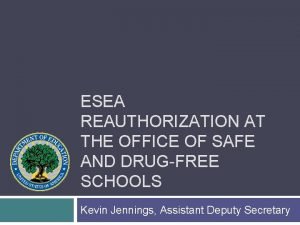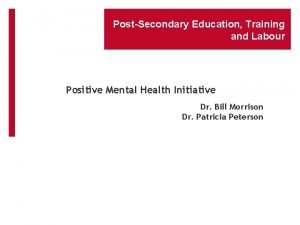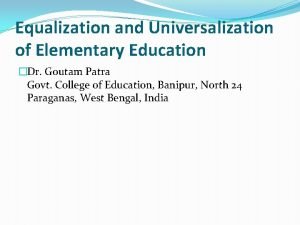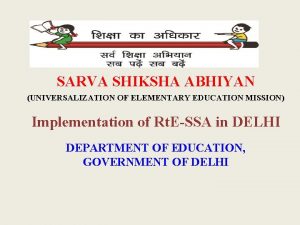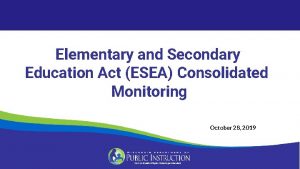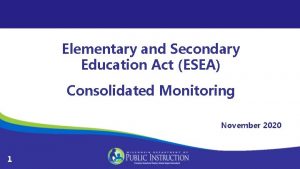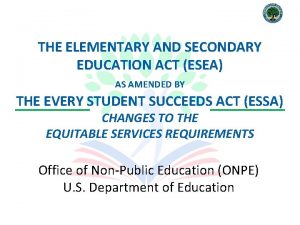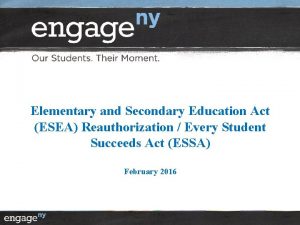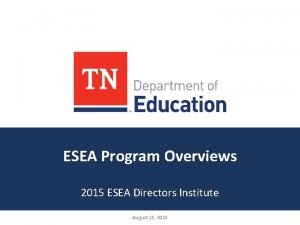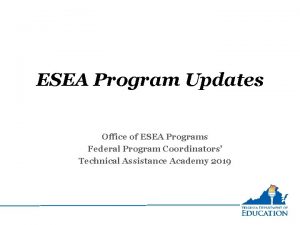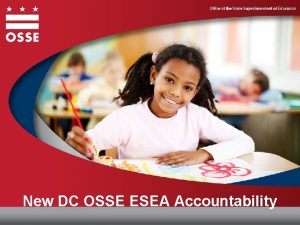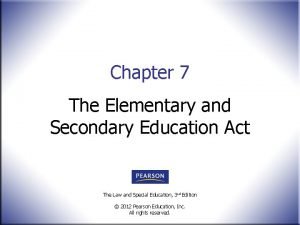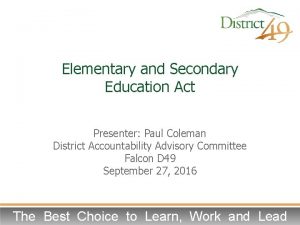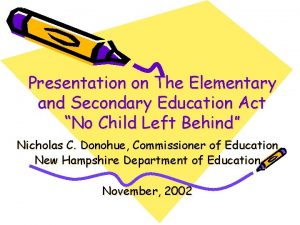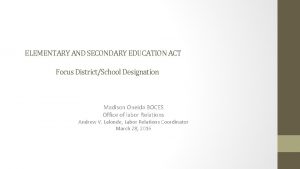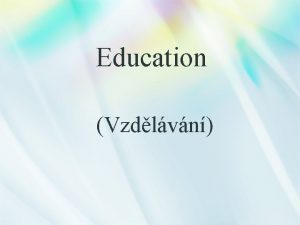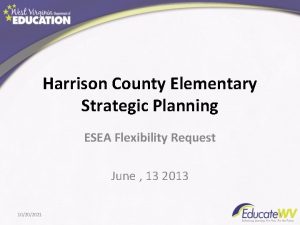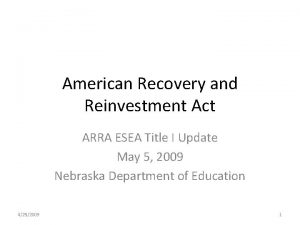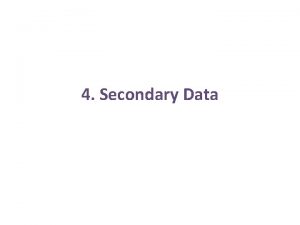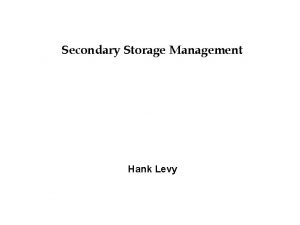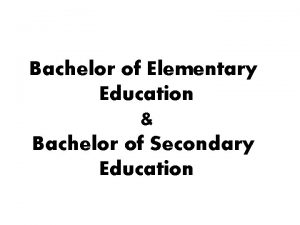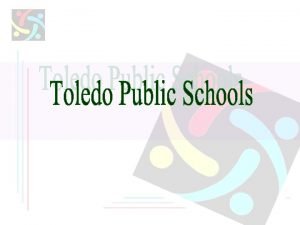The Elementary and Secondary Education Act ESEA as

































- Slides: 33

The Elementary and Secondary Education Act (ESEA) as amended by The Every Student Succeeds Act (ESSA): Equitable Services for Private School Students and Teachers Consultation Requirements U. S. Department of Education Office of Non-Public Education

Objectives Participants will gain: Understanding of the equitable services consultation requirements under the Elementary and Secondary Education Act (ESEA), as amended by the Every Student Succeeds Act (ESSA) Knowledge of resources to assist you in engaging in consultation with private schools. 2

Agenda Overview of the Office of Non-Public Education (ONPE) General Consultation Requirements Consultation Demonstration Consultation Topics Resources 3

https: //innovation. ed. gov/what-we-do/non-public-education/ 4

Elementary and Secondary Education Act (ESEA) Since the passage of the ESEA in 1965, local educational agencies (LEAs) have been required to provide equitable services to private school students, teachers, and, in some cases, other education personnel and parents under a number of the ESEA programs. 5

School Choice Participation in a Federal or State private school choice program does not affect a private school student’s eligibility for equitable services under an ESEA program. Regardless of the source of funds paying a private school student’s tuition, a student is eligible for equitable services under the ESEA if the student meets the eligibility requirements of the respective program.

EQUITABLE SERVICES CONSULTATION OVERVIEW 7

Polling Question How often do you engage in consultation with your private schools during an average 12 -month period? 0 Times q 1 -2 times q 3 -4 times q 5 -6 times q 7 or more times q 8

General Requirements LEAs are required to consult with private school officials regarding the provision of equitable services. Consultation must occur during the design, development, and implementation of Title I and programs covered under Title VIII. Consultation must occur before the LEA makes decisions that affect the opportunity of eligible private school students and teachers to participate. Consultation must continue throughout the implementation and assessment of services. ESEA sections 1117(b)(1) and 8501(c)(1) 9

Timely and Meaningful Consultation Meaningful consultation provides a genuine opportunity for all parties to express their views, to have their views seriously considered, and to discuss viable options for ensuring equitable participation of private school students, teachers, and other education personnel. Timely consultation provides adequate notice to help ensure that those involved will be well prepared with the necessary information and data for decision-making. Successful consultation establishes positive and productive working relationships, makes planning effective, and serves to ensure that the services provided meet the needs of eligible students. 10

Consultation Cycle Needs of Private School Students and Teachers How & When Decisions are Made Amount of Funds Available for Services November October Size and Scope of Services September Services Offered and Delivery of Services August Assessment of Services January December Timely and meaningful consultation must continue throughout the implementation and assessment of services and shall occur before the local education agency makes any decision that affects the opportunities to participate of eligible private school students, teachers, and other education personnel. 3 rd Party Providers July June 11 February Pooling of Funds March April May Providing Services Directly or Via Another Entity How Amount of Funding is Determined Requires Written Affirmation

12

Consultation Topics Timely and meaningful consultation between the LEA and private school officials during the design and development of the services must address the following topics: How the children’s needs will be identified; What services will be offered; How, where, and by whom the services will be provided; How the services will be assessed and how the results of the assessment will be used to improve those services; 13

Consultation Topics (Continued) The size and scope of the equitable services to be provided to the eligible private school children, teachers, and other educational personnel, and the amount of fund available for those services; and How and when the agency, consortium, or entity will make decisions about the delivery of services, including a thorough consideration and analysis of the views of the private school officials on the provision of services through potential-third party providers. 14

Consultation Topics (Continued) How the amount of funds is determined for the equitable services to be provided; Whether the agency, consortium, or entity shall provide services directly or through a separate government agency, consortium, or entity or through a third-party contractor; and Whether to provide equitable services by pooling or on a school-by-school basis. 15

Consultation Topics (Continued) Pooling The option to either pool funds for multiple private schools or provide services on a school-by-school basis is unchanged. The only change is that the statute now specifies that an LEA must consult with private school officials regarding these options. 16

Polling Question How often should you engage in consultation with your private schools during an average 12 -month period? 0 Times q 1 -2 times q 3 -4 times q 5 -6 times q 7 or more times q 17

Use of Funds Title I, Part A – Improving Basic Programs Operated by LEAs Supplementary instruction by public school teachers or through a third-party contractor to students who are educationally disadvantaged and failing or most at risk of failing to meet high academic standards Title II, Part A – Supporting Effective Instruction Provides assistance to increase student achievement, improve the quality and effectiveness of teachers, principals, and other school leaders, increase the number of teachers, principals, and other school leaders who are effective in improving student academic achievement, and to provide low-income and minority students greater access to effective teachers, principals, and other school leaders. 18

Use of Funds (cont. ) Title III, Part A – English Language Acquisition, Language Enhancement, and Academic Achievement Act Provides funds for helping English learners students attain English proficiency and meet the same challenging State academic standards required of all students. Title IV, Part A – Student Support and Academic Enrichment Grants Provides support to provide all students with access to a well-rounded education, improve school conditions for student learning, and improve the use of technology in order to improve the academic achievement and digital literacy of all students. Title IV, Part B – 21 st Century Community Learning Centers Provides before-and after-school services to children and their families that include academic enrichment activities, particularly for students who attend low-performing schools, to help them meet State and local student performance standards in core academic subjects. 19

Written Affirmation Each local educational agency shall maintain in the agency’s records, and provide to the State Educational agency involved, a written affirmation signed by officials of each participating private school that the meaningful consultation has occurred. The written affirmation shall provide the option for private school officials to indicate such officials’ belief that timely and meaningful consultation has not occurred or that the program design is not equitable with respect to eligible private school children. 20

Goal of Agreement The goal of consultation is agreement between the LEA and appropriate private school officials on how to provide equitable and effective programs for eligible private school children. 21

Idea Share What strategies will help LEAs and private school officials reach agreement? 22

Ombudsman To help ensure that private school children, teachers, and other educational personnel receive services equitable to those in public schools, SEAs must designate an ombudsman to monitor and enforce equitable services requirements. 23

Formal Complaint A private school official has the right to complain to the SEA that the LEA did not engage in timely and meaningful consultation or did not give due consideration to the views of the private school official. 24

Complaint Timeframe The timeframe that an SEA has for responding to a complaint from parents, teachers, or other individuals concerning violations of ESEA section 8501 regarding the participation by private school children and teachers is 45 days. In addition, the Secretary must investigate and resolve an appeal of an SEA’s resolution of a complaint within 90 days. 25

RESOURCES 26

Resource Share What forms or documents do you utilize in consultation with private schools? 27

Sample Resource Consultation Timeline Month LEA Activity September Begin programs and services. Consult with private school officials about current programs and services implementation and modify as necessary. October Continue consultation about current programs and services implementation. November. December Consult with private school officials about the status of current programs and services. Obtain complete list of all private schools with appropriate contact names for later use in mailing “Intent to Participate in Federal Education Programs” forms. January Continue consultation with private school officials about the status of current programs and services. Send “Intent to Participate” forms to all private schools in the LEA with a February deadline for returning the forms. February -March Continue consultation with private school officials about the status of current programs and services. Conduct a district-wide consultation meeting with all private school officials and provide a general overview of programs that will be available to their students and teachers in the next school year. Provide private school officials with planning document* to prepare them for consultation about next year’s programs and services. Consult with private school officials to identify students’ and teachers’ needs, discuss services and estimated funding figures, design programs, and establish priorities for the next school year. April-May Evaluate programs and services for the current school year and make suggestions for modifying programs that will be implemented again in the next school year. Continue consultation and planning for programs and services for next school year. Complete plans for programs and services and set dates for when they will begin in the next school year. Develop consultation timeline for the next school year. June Finalize actions related to programs and services. July-August Inform private school officials about the readiness of programs and services for the upcoming school year. Provide program funding figures to private school officials for upcoming school year. 28

Sample Resource Consultation Checklist for LEA officials Send notice about ESEA programs (Intent to Participate form) to private school administrators asking if they are interested in having their students and teachers participate in ESEA programs. Discuss how much funding is available for programs/services and how it was determined. Schedule a consultation meeting with private school officials and provide information about the ESEA education programs (including competitive grants the LEA will apply for) available to eligible private school students and teachers, allowable activities, and the appropriate roles of public and private school officials. Discuss program/services assessment and how results will be used to improve services. Obtain from private schools a list of names, roles and level of authority of private school officials who should be included in the consultation process. Discuss the use of a third-party provider and thoroughly consider the views of private school officials. If a request by private school officials for a third-party provider is declined, provide a written explanation as to the reasons why a contractor was not chosen. In consultation with private school officials, develop a timeline for periodic consultation meetings throughout the implementation of programs and services. Inform private school officials about how and when the LEA will make decisions about the delivery of services and how and the LEA will inform them of such decisions. Discuss that all materials, equipment, programs and services must be supplemental and not supplant what otherwise would be made available absent the Federal funds. Obtain sign-off from private school officials on the consultation process. Inform private school officials about policies, procedures and forms related to programs, services, equipment and materials for their students and teachers. Provide contact information to the private school officials Discuss how the needs of eligible private school students and teachers will be assessed. Discuss the type of services that are available. Discuss how, where, and by whom the services will be provided. Address the size and scope of the services to be provided. *This NCLB consultation checklist can be revised to also reflect the new ESSA requirements and changes. 29 .

Sample Resource Consultation Checklist for Private School Officials I have a general understanding of the ESEA programs available to my students and teachers. I have discussed with LEA officials how my students’ needs will be identified. The LEA official has explained what services can be offered. I have been given a genuine opportunity to present the needs of my students and teachers. I have been given the opportunity to explain how my students’ needs can best be met through this program. I participated in a discussion of how, where, and by whom the services will be provided. Student and program assessment were discussed and I understand how the results of the assessment can be used to improve the services to my students and teachers. I have been told how much funding is available for services and how the funding was determined. I know how and when the LEA will make the final decision about services and how and when I will be informed about the services. Together, the LEA and I have set dates for periodic meetings throughout the implementation of the program so that we can discuss the progress of the program or make modifications, if needed, to improve effectiveness. I have provided a sign-off on the consultation process and the program services to be provided to my students and teachers. I am aware of deadlines for submitting requests and providing necessary information. I have been given a genuine opportunity to have my views heard and considered. I know whom to contact if I have questions or concerns. I have had an opportunity to genuinely express my views on the use of a third-party provider. If a third-party provider was requested, there was a thorough consideration and analysis of this proposal. If a third-party was requested and not granted, a written explanation has been provided as to the reasons why the LEA has chosen not to use a third-party provider. *This NCLB consultation checklist can be revised to also reflect the new ESSA requirements and changes. 30

ESSA Guidance Read in Conjunction with NCLB Guidance Non-Regulatory Guidance: Fiscal Changes and Equitable Services Requirements Non-Regulatory Guidance for Title II, Part A: Building Systems of Support for Excellent Teaching and Leading Non-Regulatory Guidance: English Learners and Title III of the Elementary and Secondary Education Act as amended by the Every Student Succeeds Act Non-Regulatory Guidance Student Support and Academic Enrichment Grants (Title IV, Part A) Key ESSA Resources available at: http: //www 2. ed. gov/policy/elsec/leg/essa/index. html 31

NCLB Guidance Title I Services to Eligible Private School Students (October 2003) Title III, Part A Equitable Services to Private School Students, Teachers, and Other Educational Personnel Non-Regulatory Guidance (July 2015) Title IX, Part E Uniform Provisions Equitable Services for Eligible Private School Students, Teachers, and Other Educational Personnel Non-Regulatory Guidance (March 2009) 32

Questions? 33
 Is esea safe
Is esea safe Act 1 act 2 act 3
Act 1 act 2 act 3 Post secondary education training and labour
Post secondary education training and labour Universalization of retention
Universalization of retention Role of ssa in universalisation of elementary education
Role of ssa in universalisation of elementary education Susan belgrad
Susan belgrad Hình ảnh bộ gõ cơ thể búng tay
Hình ảnh bộ gõ cơ thể búng tay Lp html
Lp html Bổ thể
Bổ thể Tỉ lệ cơ thể trẻ em
Tỉ lệ cơ thể trẻ em Voi kéo gỗ như thế nào
Voi kéo gỗ như thế nào Chụp tư thế worms-breton
Chụp tư thế worms-breton Chúa yêu trần thế
Chúa yêu trần thế Môn thể thao bắt đầu bằng chữ f
Môn thể thao bắt đầu bằng chữ f Thế nào là hệ số cao nhất
Thế nào là hệ số cao nhất Các châu lục và đại dương trên thế giới
Các châu lục và đại dương trên thế giới Công thức tiính động năng
Công thức tiính động năng Trời xanh đây là của chúng ta thể thơ
Trời xanh đây là của chúng ta thể thơ Mật thư anh em như thể tay chân
Mật thư anh em như thể tay chân Phép trừ bù
Phép trừ bù Phản ứng thế ankan
Phản ứng thế ankan Các châu lục và đại dương trên thế giới
Các châu lục và đại dương trên thế giới Thơ thất ngôn tứ tuyệt đường luật
Thơ thất ngôn tứ tuyệt đường luật Quá trình desamine hóa có thể tạo ra
Quá trình desamine hóa có thể tạo ra Một số thể thơ truyền thống
Một số thể thơ truyền thống Cái miệng nó xinh thế
Cái miệng nó xinh thế Vẽ hình chiếu vuông góc của vật thể sau
Vẽ hình chiếu vuông góc của vật thể sau Nguyên nhân của sự mỏi cơ sinh 8
Nguyên nhân của sự mỏi cơ sinh 8 đặc điểm cơ thể của người tối cổ
đặc điểm cơ thể của người tối cổ Ví dụ về giọng cùng tên
Ví dụ về giọng cùng tên Vẽ hình chiếu đứng bằng cạnh của vật thể
Vẽ hình chiếu đứng bằng cạnh của vật thể Fecboak
Fecboak Thẻ vin
Thẻ vin đại từ thay thế
đại từ thay thế
